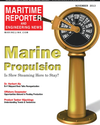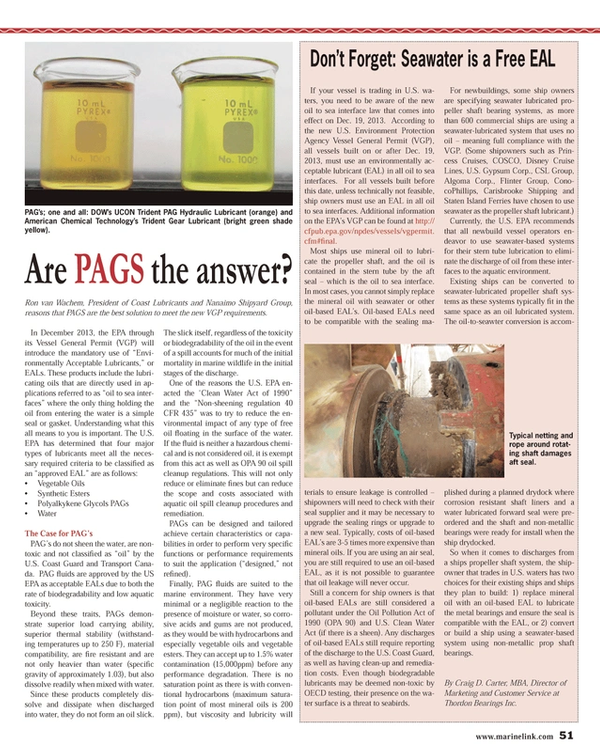
Are PAGS the Answer?
Ron van Wachem, President of Coast Lubricants and Nanaimo Shipyard Group, reasons that PAGS are the best solution to meet the new VGP requirements.
In December 2013, the EPA through its Vessel General Permit (VGP) will introduce the mandatory use of “Environmentally Acceptable Lubricants,” or EALs. These products include the lubricating oils that are directly used in applications referred to as “oil to sea interfaces” where the only thing holding the oil from entering the water is a simple seal or gasket. Understanding what this all means to you is important. The U.S. EPA has determined that four major types of lubricants meet all the necessary required criteria to be classified as an “approved EAL” are as follows:
• Vegetable Oils
• Synthetic Esters
• Polyalkykene Glycols PAGs
• Water
The Case for PAG’s
PAG’s do not sheen the water, are non-toxic and not classified as “oil” by the U.S. Coast Guard and Transport Canada. PAG fluids are approved by the US EPA as acceptable EALs due to both the rate of biodegradability and low aquatic toxicity.
Beyond these traits, PAGs demonstrate superior load carrying ability, superior thermal stability (withstanding temperatures up to 250 F), material compatibility, are fire resistant and are not only heavier than water (specific gravity of approximately 1.03), but also dissolve readily when mixed with water.
Since these products completely dissolve and dissipate when discharged into water, they do not form an oil slick. The slick itself, regardless of the toxicity or biodegradability of the oil in the event of a spill accounts for much of the initial mortality in marine wildlife in the initial stages of the discharge.
One of the reasons the U.S. EPA enacted the ‘Clean Water Act of 1990” and the “Non-sheening regulation 40 CFR 435” was to try to reduce the environmental impact of any type of free oil floating in the surface of the water. If the fluid is neither a hazardous chemical and is not considered oil, it is exempt from this act as well as OPA 90 oil spill cleanup regulations. This will not only reduce or eliminate fines but can reduce the scope and costs associated with aquatic oil spill cleanup procedures and remediation.
PAGs can be designed and tailored achieve certain characteristics or capabilities in order to perform very specific functions or performance requirements to suit the application (“designed,” not refined).
Finally, PAG fluids are suited to the marine environment. They have very minimal or a negligible reaction to the presence of moisture or water, so corrosive acids and gums are not produced, as they would be with hydrocarbons and especially vegetable oils and vegetable esters. They can accept up to 1.5% water contamination (15,000ppm) before any performance degradation. There is no saturation point as there is with conventional hydrocarbons (maximum saturation point of most mineral oils is 200 ppm), but viscosity and lubricity will slowly be reduced as the water content is increased. PAG fluids also offer excellent corrosion protection if affected by water; after all, water glycol hydraulic fluids used in the steel and smelting industry contain up to 45% water. Vessel owners are now all looking at the new EPA VGP regulations which come into effect at the end of this year. They need to realize what they are trying to achieve now and in the long run. Environmental compliance should be at the top or near the top of that list. Next should be cost effectiveness and performance. In the past, many ship and equipment managers avoided using vegetable oils and mineral oils as they are viewed as costly and inferior lubricants that require much more maintenance and bring their own set of problems. The petroleum and lubricant industry often dismiss PAGs because they are not compatible with other conventional oils and are not produced by major refiners. PAG fluids such as Dow’s UCON Trident AW, BASF Plurasafe Enbio TC, and American Chemicals Technology’s Neptune (including EP and XP) lubricants are anhydrous, or contain no water, and offer the performance characteristics listed above. PAG fluids have already solved high heat and varnish issues in harsh applications such as compressor and turbine fluids, where even PAOs were failing due to the severe heat and friction (American Chemical Technologies have now received approval from GE to use PAGs in its turbines). Shipowners are now realizing that PAGs can offer more than just a solution to the VGP issue but also the benefit PAGs can have to their compressors and other equipment that are subject to harsh operating conditions in marine environments. PAGs are often said to be very costly, but take into account their performance characteristics, long life, environmental footprint, etc., and they can be proven to be cost effective.
(As published in the November 2013 edition of Maritime Reporter & Engineering News - www.marinelink.com)
Read Are PAGS the Answer? in Pdf, Flash or Html5 edition of November 2013 Maritime Reporter
Other stories from November 2013 issue
Content
- Interview: Dr. Herbert Aly page: 12
- Knowledge is Power page: 16
- ReFRESCO: Understanding & Designing Energy Saving Devices page: 18
- Nontank VRP Regs page: 20
- The Magic Ingredients of a Healthy Safety Culture page: 24
- e-Compliance: Revolutionizing the Efficiency of Compliance for Maritime Regs page: 28
- Pull the Handle Down... page: 30
- Return of the Electric Boat page: 38
- Fast Ferry Gets a New Power Package page: 42
- Cat tackles Tier 3 and Tier 4; Completes Berg Deal page: 44
- Konrad, Cummins Propulsion Package Partnership page: 46
- Scania 13L Inline; 16L V8 for EPA Tier 3 page: 48
- The Switch: New Drive Train Tech page: 48
- John Deere Tier 3 Engine Line Up page: 49
- GE Power Conversion page: 49
- EPA’s Vessel General Permit (VGP) & You page: 50
- Are PAGS the Answer? page: 51
- Don’t Forget: Seawater is a Free EAL page: 51
- Lukoil: Cylinder Oil to Reduce Wear, Consumption page: 52
- Agip Rebrands as Eni Powers Ahead in North America page: 52
- Floating Production Systems: Market Update page: 54
- Offshore Brazil: The Libra Field & Brazil’s Pre-Salt Policy page: 56
- On Ballast Water, Time is Running Out page: 60
- Standardization for Safer Shipping of e-Navigation & Training page: 62
- Apprenticeship Training & Academic Degree: The Pathway to Success page: 64
- The Drawing Board: Innovative OSV Design from the Ground up page: 68
- Product Tanker Hijackings page: 72
- The Trinidad & Tobago Maritime Sector page: 74
- Seatorque Boost for Brazil’s Biggest Superyacht page: 76
- Raytheon Anschütz Launches New Gyro Compass page: 85
- Emsys Upgraded to Measure Mass Emissions Rates page: 85
- Thuraya SatSleeve Transforms iPhone into Satellite Phone page: 85
- Kongsberg Debuts New Drilling Rig and Ship Simulator page: 85
- Martek: “BNWAS Password Protection is Essential” page: 85
- Northrop Grumman Radars for USN page: 85
- Imtech Debuts SeaPilot 76 page: 85
- FORAN in Indonesia page: 85
- Raymarine Autopilot page: 86
- Computer Gaming & Maritime Training page: 86
- Jeppesen Updates VVOS Software page: 86
- Harris CapRock & Carnival Sign Contract page: 86
- Carlisle & Finch SmartVIEW Technology page: 86
- Thomas Gunn Unveils New Digital Chart Management System page: 86
- CM-1000 Series: Smart Fluid Handling Tech page: 87
- Paperless Navigation page: 87
- TNKC Fleet & BASS Software page: 87
- Cobham Touchscreen Navtex page: 87
- GE Dynamic Positioning System page: 87
- Ecospeed Fuel Savings Calculator page: 87
- Boatracs’ BTConnect AIS page: 87
- New Brakes from Wichita Clutch page: 88
- Home Study Programs page: 88
- New PowerShark Tool Eats through Biofouling page: 88
- VIKING Expands Training page: 88
- SUPREME Athmos Zero-Pollution Seal page: 88
- New Inertia-Engaged Turbine Air Starter page: 88


